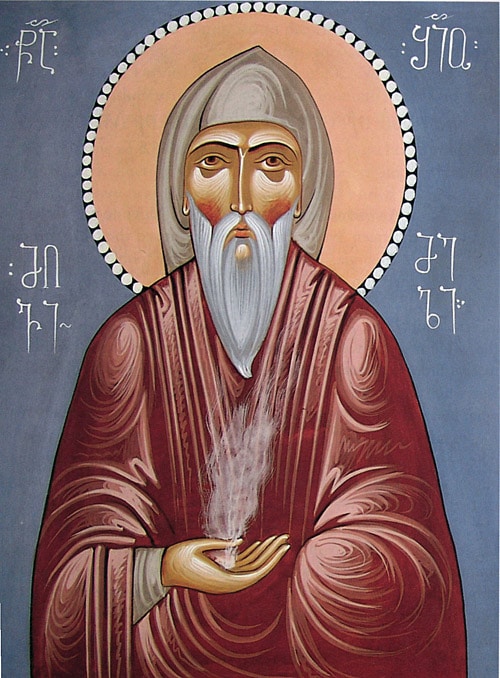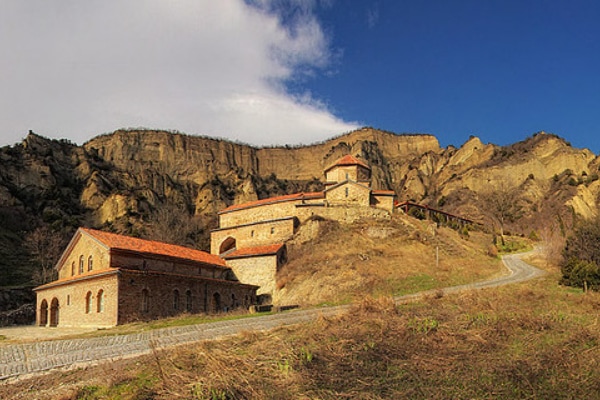 10 km West of Mtskheta in the mountains of dzegvi village there is a functioning monastery of Shio-Mgvime (Simeon of Mgvime, VI century). The monastery literally merges with the sandy color of the mountain slopes. However, when its outlines begin to appear, it is immediately clear how ancient this monument is. The very first building of the monastery complex is a Church Dating back to the VI century. It is a small and low structure with a two-tiered dome. This Church is one of the most important ancient monuments. Buildings, similar to shiomgvime monastery, in Georgia, no longer exists.
10 km West of Mtskheta in the mountains of dzegvi village there is a functioning monastery of Shio-Mgvime (Simeon of Mgvime, VI century). The monastery literally merges with the sandy color of the mountain slopes. However, when its outlines begin to appear, it is immediately clear how ancient this monument is. The very first building of the monastery complex is a Church Dating back to the VI century. It is a small and low structure with a two-tiered dome. This Church is one of the most important ancient monuments. Buildings, similar to shiomgvime monastery, in Georgia, no longer exists.
The shiomghvime monastery more than three hundred years under the patronage of the prince’s amilakhvari was their family burial place. Georgians believe that the revival of the Orthodox Church in modern Georgia began with the revival of this monastery.
The history of the monastery began at a time when the Assyrian fathers dispersed from the Zedazen Mountain at all ends of the Eastern Shio-Mgvime and here, in the gorge behind Mtskheta, Saint Shio came and settled in a cave on the mountainside. One of the first followers of St. Shio was Evagrius, who owned the fortress of Chikhadiye near South over Mtkvari. One day he went to the mountains to hunt and saw Shio there. He decided to stay with him, sold all his property, distributed to the poor and became a monk.
The oldest and the first building on the territory of the complex is considered to be the temple of John the Baptist, built presumably at the end of the VI century, during the life of St. Shio. It is believe that Shio chose the place for the laying of the temple. To this end, he laid it on the arm of the burning incense, and went where pointed out the smoke. So icons often depict Shio steaming on the hand of incense.
By 560-580, the monks dug caves and cells, which now surround the monastery and are visible from the road leading to the monastery complex. The upper Church, named after the Mother of God, built in the early 12th century by order of King David IV. Initially, the temple had a dome, but during the invasion of Shah Abbas in 1614, the temple destroyed and restored only half a century later, in 1678. It was restore in a simplified form, like a Basilica.
Shio Mgvime (Simeon) was a Saint of the Georgian Church, born in Antioch, the son of wealthy parents. Shio Mgvime gave all his estate, went to St. John, who lived near Antioch, which took Shio with him to Iberia. Shio Mgvime settled in the wilderness near Mtskheta. King Parsman VI, who visited the former favorite of his Evagrius in the desert, who had gone to Shio-Mgvime, gave the land for a monastery and brought considerable funds for the construction of temples. The number of brethren of the new monastery increased to 2000. However, the desire for complete solitude prevailed in the soul of Shio Mgvime. After leaving the Shio-Mgvime monastery founded by him, Shio-Mgvime left 160 written teachings for the brethren, and he doomed himself to a reclusive life in a dark deep cave. Died Shio Mgvime in the VII century. The power of Shio Mgvime rest in monastery Samtavro.
After Shio’s death, the monastery became a center of cultural and religious activities and was under the personal patronage of the Catholics of Georgia. David IV the Builder (1089-1125) made the Shio-Mgvime monastery the Royal domain and dictated the rules for the monastery (1123). The fall of the unified Georgian Kingdom and the incessant foreign invasions brought the Shio-Mgvime monastery into decline. The period of relative revival came when the Georgian king George VIII (1446-1465) provides Shio-Mgvime monastery and its lands to the noble family of Tavdgiridze-amilakhvari, which until 1810 years used it as a family tomb
Shio-Mgvime monastery was devastated by the invasion (1614-1616) the Persian armies of Shah Abbas I. the Prince Givi amilakhvari restored the monastery in 1678, but in 1720 the Ottoman occupation of Georgia brought another destruction of the Shio-Mgvime monastery. The Persians again destroyed the monastery, restored amilakhvari in 1733, less than two years later. Subsequently, the Shio-Mgvime monastery restored, its interior renovated in the XIX century, but the monastery could not return its past importance in the spiritual life of Georgia. During the Soviet period, the Shio-Mgvime monastery closed, part of the relics of St. Shio stored in the monastery burned, but one bone was preserved. Despite the fact that in Soviet time the monastery closed, the monks still continued secretly worship.
Shio-Mgvime
Do you have any questions or would you like to visit sight?
Please fill in the following form and we will contact you.
[fc id=’7′ align=’left’][/fc]



